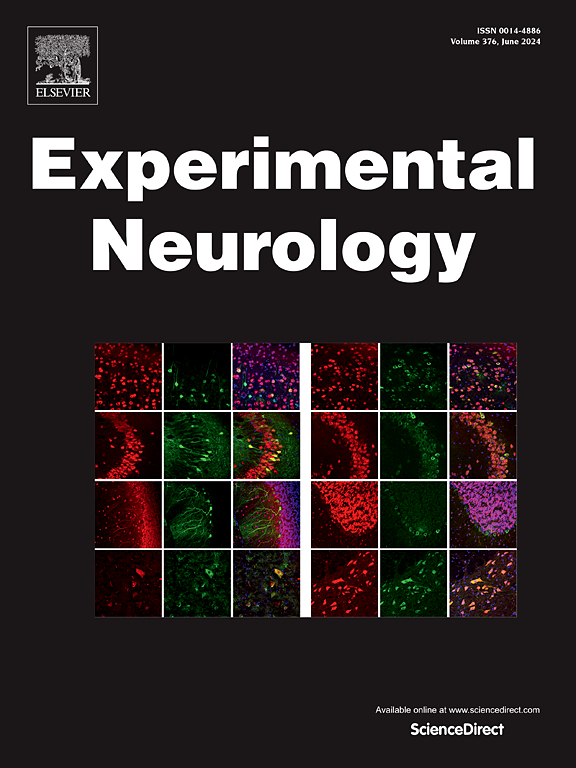阿尔茨海默病转基因小鼠中风后,粪便来源的细胞外囊泡增加炎性小体信号并调节肠-脑轴
IF 4.6
2区 医学
Q1 NEUROSCIENCES
引用次数: 0
摘要
阿尔茨海默病(AD)患者卒中后肠道功能障碍表现为神经系统预后恶化。本研究探讨了3xTg- AD和野生型(WT)老年小鼠光血栓性卒中(PTS)后,粪便来源的细胞外囊泡(EV)介导的炎性体信号在肠-脑轴中的作用。Western Blot和免疫组织化学分析评估了肠道和皮质组织中的炎性小体信号蛋白、Gasdermin D (GSDMD)和Aβ。PTS后3天采用fitc -葡聚糖法测定肠道通透性。过继性转移实验评估了PTS小鼠粪便来源的ev对受体naïve 3xTg和WT小鼠炎症小体信号传导的影响。在第3天,与WT-PTS小鼠相比,3xTg-PTS小鼠表现出明显的感觉运动Rotarod功能受损。与3xTg和WT假小鼠相比,WT和3xTg PTS小鼠在开放场或新物体识别测试中都存在缺陷。与WT- PTS小鼠相比,3xTg-PTS小鼠在PTS后1个月的肠道形态被破坏,在72小时的肠道通透性增加。免疫组织化学分析还显示3xTg和WT小鼠在PTS后的大脑和肠道中激活的小胶质细胞形态和GSDMD和Aβ的存在。将粪便来源的ev从PTS小鼠过继转移到WT小鼠可诱导受体大脑皮层炎症小体信号蛋白水平升高。这些发现表明,在老年WT和3xTg小鼠中风后肠-脑双向轴的破坏导致AD病理恶化中,粪便来源的EV炎性体信号和焦亡发挥了重要作用。本文章由计算机程序翻译,如有差异,请以英文原文为准。

Stool-derived extracellular vesicles increase inflammasome signaling and regulate the gut-brain axis after stroke in Alzheimer's disease transgenic mice
Patients with Alzheimer's disease (AD) suffering from post-stroke gut dysfunction present with worsened neurological outcomes. This study investigated the role of stool-derived extracellular vesicle (EV)-mediated inflammasome signaling in the gut-brain axis following photothrombotic stroke (PTS) in aged 3xTg- AD and wildtype (WT) mice. Western Blot and immunohistochemical analyses evaluated inflammasome signaling proteins, Gasdermin D (GSDMD), and Aβ in intestinal and cortical tissues. Gut permeability was measured using a FITC-dextran assay 3 days post PTS. Adoptive transfer experiments assessed the impact of stool-derived EVs from PTS mice on inflammasome signaling in recipient naïve 3xTg and WT mice. At 3 days, 3xTg-PTS mice demonstrated significantly impaired sensorimotor Rotarod performance compared to WT-PTS mice. Both WT and 3xTg PTS mice had deficits compared to 3xTg and WT sham mice using the Open Field or Novel Object Recognition tests. Compared to WT- PTS mice, 3xTg-PTS mice had disrupted gut morphology at 1-month post-PTS, as well as increased gut permeability at 72 h. Immunohistochemical analysis also revealed activated microglial morphology and presence of GSDMD and Aβ in the brain and intestines post-PTS in 3xTg and WT mice. Adoptive transfer of stool-derived EVs from PTS mice to WT mice induced elevated levels of inflammasome signaling proteins in recipient cerebral cortices. These findings indicate an important role of stool-derived EV inflammasome signaling and pyroptosis in disruption of the bidirectional gut-brain axis after stroke leading to exacerbation of AD pathology in aged WT and 3xTg mice.
求助全文
通过发布文献求助,成功后即可免费获取论文全文。
去求助
来源期刊

Experimental Neurology
医学-神经科学
CiteScore
10.10
自引率
3.80%
发文量
258
审稿时长
42 days
期刊介绍:
Experimental Neurology, a Journal of Neuroscience Research, publishes original research in neuroscience with a particular emphasis on novel findings in neural development, regeneration, plasticity and transplantation. The journal has focused on research concerning basic mechanisms underlying neurological disorders.
 求助内容:
求助内容: 应助结果提醒方式:
应助结果提醒方式:


